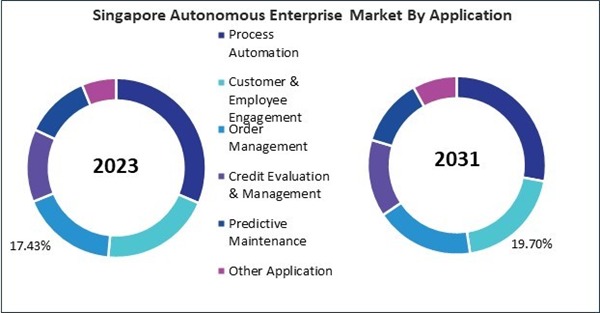The Asia Pacific Autonomous Enterprise Market is expected to witness market growth of 18.2% CAGR during the forecast period (2024-2031).
The China market dominated the Asia Pacific Autonomous Enterprise Market by Country in 2023, and is expected to continue to be a dominant market till 2031; thereby, achieving a market value of USD11.14 billion by 2031. The Japan market is registering a CAGR of 17.4% during 2024-2031. Additionally, the India market would showcase a CAGR of 19% during 2024-2031.
This market is also significantly influenced by the growing availability and maturity of enabling technologies. Artificial intelligence (AI) and machine learning (ML) have made substantial progress in recent years as algorithms have become increasingly precise and capable of managing intricate tasks. The expansion of these enterprises has been significantly influenced by the proliferation of IoT, as connected devices generate substantial quantities of data that can be employed to enhance operations.
These technologies have become more accessible as a result of cloud computing, which enables small and medium-sized enterprises (SMEs) to utilize sophisticated automation without the necessity of a substantial on-premise infrastructure. The capabilities of autonomous enterprises will continue to expand as technology continues to develop, thereby further stimulating market growth.
India is embracing autonomous technologies in transportation and logistics, driven by rapid urbanization and the increasing demand for efficient last-mile delivery solutions. Autonomous vehicles are being introduced for commercial transportation, particularly in densely populated urban areas. The government’s Aatmanirbhar Bharat Abhiyan program promotes domestic production and innovation, which includes autonomous vehicle technologies and AI-driven logistics solutions. By supporting local manufacturers and startups, India aims to reduce dependence on imports and increase self-sufficiency in technology development. Hence, the rapid rise of automation in the region will drive the market's growth.
Based on Offering, the market is segmented into Solution (Robotic Process Automation, Autonomous Networks, Accounts Automation & Security Automation, and Autonomous Agents & Others) and Services (Professional Services and Managed Services). Based on Business Functions, the market is segmented into Sales & Marketing, Accounting & Finance, Supply Chain & Operations, Human Resource (HR), and IT.
The China market dominated the Asia Pacific Autonomous Enterprise Market by Country in 2023, and is expected to continue to be a dominant market till 2031; thereby, achieving a market value of USD11.14 billion by 2031. The Japan market is registering a CAGR of 17.4% during 2024-2031. Additionally, the India market would showcase a CAGR of 19% during 2024-2031.
This market is also significantly influenced by the growing availability and maturity of enabling technologies. Artificial intelligence (AI) and machine learning (ML) have made substantial progress in recent years as algorithms have become increasingly precise and capable of managing intricate tasks. The expansion of these enterprises has been significantly influenced by the proliferation of IoT, as connected devices generate substantial quantities of data that can be employed to enhance operations.
These technologies have become more accessible as a result of cloud computing, which enables small and medium-sized enterprises (SMEs) to utilize sophisticated automation without the necessity of a substantial on-premise infrastructure. The capabilities of autonomous enterprises will continue to expand as technology continues to develop, thereby further stimulating market growth.
India is embracing autonomous technologies in transportation and logistics, driven by rapid urbanization and the increasing demand for efficient last-mile delivery solutions. Autonomous vehicles are being introduced for commercial transportation, particularly in densely populated urban areas. The government’s Aatmanirbhar Bharat Abhiyan program promotes domestic production and innovation, which includes autonomous vehicle technologies and AI-driven logistics solutions. By supporting local manufacturers and startups, India aims to reduce dependence on imports and increase self-sufficiency in technology development. Hence, the rapid rise of automation in the region will drive the market's growth.
Based on Offering, the market is segmented into Solution (Robotic Process Automation, Autonomous Networks, Accounts Automation & Security Automation, and Autonomous Agents & Others) and Services (Professional Services and Managed Services). Based on Business Functions, the market is segmented into Sales & Marketing, Accounting & Finance, Supply Chain & Operations, Human Resource (HR), and IT.
List of Key Companies Profiled
- Microsoft Corporation
- IBM Corporation
- Amazon Web Services, Inc. (Amazon.com, Inc.)
- Check Point Software Technologies Ltd.
- Pegasystems Inc.
- Cisco Systems, Inc.
- Hewlett Packard Enterprise Company
- SAP SE
- ATOSS Software SE
- Oracle Corporation
Market Report Segmentation
By Offering
- Solution
- Robotic Process Automation
- Autonomous Networks
- Accounts Automation & Security Automation
- Autonomous Agents & Others
- Services
- Professional Services
- Managed Services
By Business Functions
- Sales & Marketing
- Accounting & Finance
- Supply Chain & Operations
- Human Resource (HR)
- IT
By Application
- Process Automation
- Customer & Employee Engagement
- Order Management
- Credit Evaluation & Management
- Predictive Maintenance
- Other Application
By Vertical
- BFSI
- IT & ITes
- Manufacturing
- Healthcare
- Transportation & Logistics
- Telecom
- Retail & eCommerce
- Government & Defence
- Other Vertical
By Country
- China
- Japan
- India
- South Korea
- Singapore
- Malaysia
- Rest of Asia Pacific
Table of Contents
Chapter 1. Market Scope & Methodology
Chapter 2. Market at a Glance
Chapter 3. Market Overview
Chapter 4. Competition Analysis - Global
Chapter 5. Asia Pacific Autonomous Enterprise Market by Offering
Chapter 6. Asia Pacific Autonomous Enterprise Market by Business Functions
Chapter 7. Asia Pacific Autonomous Enterprise Market by Application
Chapter 8. Asia Pacific Autonomous Enterprise Market by Vertical
Chapter 9. Asia Pacific Autonomous Enterprise Market by Country
Chapter 10. Company Profiles
Companies Mentioned
Some of the key companies in the Asia-Pacific Autonomous Enterprise Market include:- Microsoft Corporation
- IBM Corporation
- Amazon Web Services, Inc. (Amazon.com, Inc.)
- Check Point Software Technologies Ltd.
- Pegasystems Inc.
- Cisco Systems, Inc.
- Hewlett Packard Enterprise Company
- SAP SE
- ATOSS Software SE
- Oracle Corporation
Methodology

LOADING...









